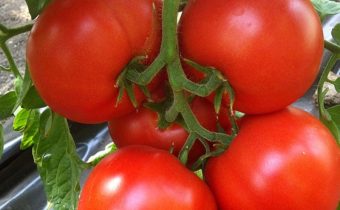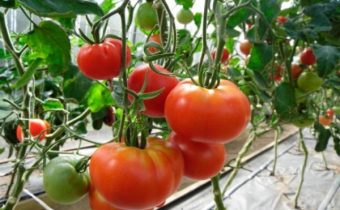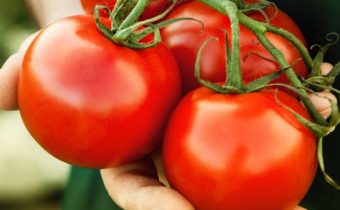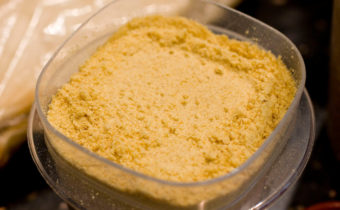We fertilize tomatoes wisely: we use phosphoric dressings
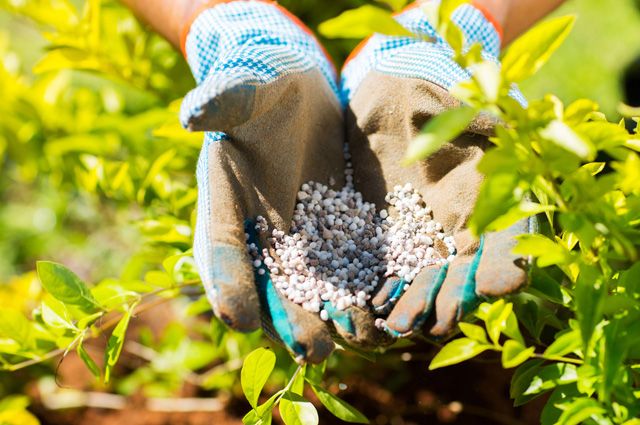
Phosphorus enters the triad of the most important elements needed by tomatoes. It allows tomato bushes to grow strong and healthy, and generally accelerates the ripening of the crop. With its lack of soil, gardeners make phosphate fertilizers. They are of different types, concentrations and properties.
The value of phosphorus for tomatoes
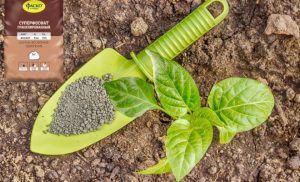 Without this element, no plant can fully exist, and each crop needs its own dose of substance. While potassium and nitrogen affect taste and juiciness, phosphorus helps the plant grow and form fruits. Therefore, without it, it is impossible to obtain a high-quality abundant harvest. The purpose of this trace element is to control the metabolic processes occurring in the plant body. There is phosphorus - there is energy. And there is energy - there is a healthy strong tomato bush with numerous fruits.
Without this element, no plant can fully exist, and each crop needs its own dose of substance. While potassium and nitrogen affect taste and juiciness, phosphorus helps the plant grow and form fruits. Therefore, without it, it is impossible to obtain a high-quality abundant harvest. The purpose of this trace element is to control the metabolic processes occurring in the plant body. There is phosphorus - there is energy. And there is energy - there is a healthy strong tomato bush with numerous fruits.
Fact!
The peculiarity of all phosphate fertilizers is that they cannot overfeed the plants. It is considered a passive element that representatives of the flora consume only in the quantities they need.
Absorbing this microcell, plants:
- grow healthy, with good immunity;
- build up a powerful root system;
- bloom profusely and knit the fruit;
- form capable seeds;
- form large juicy fruits.
Note!
The phosphates which got to the soil are inactive. This fact suggests another - they are not washed out of the soil, but are stored in the upper layer. Therefore, some phosphate fertilizers need only be applied once every several years.
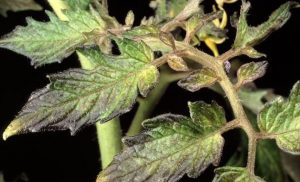
Signs of phosphorus deficiency
Phosphorus for plants is absolutely harmless, so it is almost impossible to overfeed tomatoes with a trace element. Even if phosphorus-containing fertilizers were poured a lot, tomato bushes will take from them exactly as much as is needed for full development. Most often there is a lack of phosphorus in the soil, from which the plants are very affected. Deficiency slows the growth and development of seedlings.
Main signs of shortage:
- leaves are small, have a grayish or dark purple color;
- the lower leaves are covered with dark spots;
- leaves curl, shrink, fall to the stem;
- streaks turn purple;
- the root system is developing poorly. If you slightly pull the seedling up, it will easily come out;
- poor flowering;
- fruiting is not long;
- the fruits themselves are small, tasteless.
Many of the symptoms of phosphorus starvation are similar to changes in the body of plants when quenching seedlings. When staying in the cold for a long time, the leaves may darken and wither, but with the arrival of heat the problem disappears and the leaves take on a healthy appearance. If this does not happen during the week, urgently feed seedlings phosphorus-containing drug.
Why sometimes not enough phosphorus
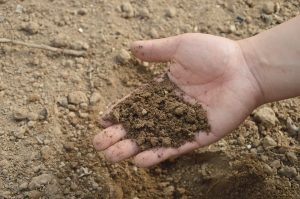 The lack of an element is often observed when the gardener incorrectly uses phosphorus-potassium fertilizers or forgets about them altogether. Errors inducing phosphorus deficiency are as follows:
The lack of an element is often observed when the gardener incorrectly uses phosphorus-potassium fertilizers or forgets about them altogether. Errors inducing phosphorus deficiency are as follows:
- intensive farming without organic and minerals;
- fertilization without taking into account the characteristics of the soil composition;
- phosphorus does not follow the instructions. In these cases, the element takes difficultly soluble forms and is not absorbed;
- wrong fertilizer concentrate;
- neglect summer feedings.
Phosphorus and soil composition
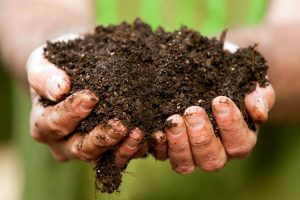 When applying phosphate fertilizers, it is necessary to take into account the composition of the soil, since the digestibility of the trace element will depend on it. On the chernozem soil, the root system of plants develops (grows) better, it becomes more enduring and immune-immune. On forest lands, it is better to combine phosphorus and nitrogen - so trace elements will be more efficiently consumed by plants. In such a soil, even if there is enough phosphorus, but not enough nitrogen, the first element will be consumed poorly.
When applying phosphate fertilizers, it is necessary to take into account the composition of the soil, since the digestibility of the trace element will depend on it. On the chernozem soil, the root system of plants develops (grows) better, it becomes more enduring and immune-immune. On forest lands, it is better to combine phosphorus and nitrogen - so trace elements will be more efficiently consumed by plants. In such a soil, even if there is enough phosphorus, but not enough nitrogen, the first element will be consumed poorly.
When adding phosphate fertilizers, it is necessary to take into account the degree of soil acidity. At elevated pH levels, phosphorus becomes difficult to assimilate, and therefore the plants will not receive the optimal dose of phosphate nutrition, even if the entire area is covered with this microelement. In this case, before fertilizing, soil deoxidation is carried out: ash or lime is applied. On slightly acidic and normal soils phosphate fertilizers are used in accordance with the instructions.
Terms of phosphate fertilizers
- Phosphorus-containing fertilizers are first applied to the soil during the autumn digging of the site. For several months of winter, the trace element will have time to fully digest the soil.
- Granular fertilizers are applied only at the root, and not scattered over the entire surface of the earth. It does not make sense to do this, since the granules will not dissolve in the upper soil layer.
- If you want to achieve a quick effect, use liquid phosphate dressings using soluble preparations. They can be used during the cultivation of the culture or when digging the soil.
- In addition to root feeding, phosphorus can be “applied” by spraying. The main thing is to breed fertilizer with water.
- Phosphorus is not added to the acidic soil - it will not show any result, since phosphorus in such a soil is not absorbed. Before fertilizing the soil is liquefied with lime or ash.
- Organic phosphate fertilizers are absorbed by the soil for much longer. Their effectiveness can be seen only 2-3 years after application to the soil.
Note!
Some phosphate fertilizers cannot be applied immediately after liming. For example, superphosphate is used only two months after the procedure of soil deoxidation.
Types and classification of phosphate fertilizers
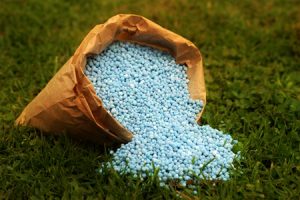 Before you buy phosphate fertilizers, you need to understand what types they are and what they are. First of all, all fertilizers containing phosphorus are divided into water-soluble, insoluble in water and in acidic soils. Agrochemicals are produced in the form of bulk powders and granules. Pellets are usually applied to the soil when digging the area, and not scattered on the ground. Bulk dissolve in water and arrange liquid dressings.
Before you buy phosphate fertilizers, you need to understand what types they are and what they are. First of all, all fertilizers containing phosphorus are divided into water-soluble, insoluble in water and in acidic soils. Agrochemicals are produced in the form of bulk powders and granules. Pellets are usually applied to the soil when digging the area, and not scattered on the ground. Bulk dissolve in water and arrange liquid dressings.
|
View |
Fertilizer name |
How does it work |
| Water soluble phosphates |
Simple superphosphate, double superphosphate, superphos |
Contribute to building root mass, strengthen them. |
| Lemon and citrate soluble (water insoluble) | Precipitate, tomasshlak, thermophosphates, free fluorinated phosphates, bone meal, fused magnesium phosphate | Do not dissolve in water - only acid will help. Used when sowing seeds and planting seedlings. Quickly compensate for the lack of phosphorus in the soil. |
| Insoluble (sparingly soluble) phosphates in water and weak acids | Phosphoric flour, diammophos, vivianite (marsh ore) | Well act on plants when added with nitric compounds and interaction with sulfuric acids. Most effective in acidic soil. They have a long-lasting effect, therefore it is preferable to use when digging the field in autumn. |
All fertilizers have a different phosphorus concentrate. Depending on its dosage, there are three groups of phosphate fertilizers:
- mineral;
- complex formulations;
- organic, not containing any chemical elements. Exceptionally natural products.
Mineral compounds (monocomponent):
| View | Substance% | Characteristic |
| Superphosphate | 20-26% digestible phosphorus | The most common phosphate fertilizer, which is composed of a small admixture of sulfur and magnesium. The use of superphosphate has an instant positive effect on tomatoes. Available in powder or granule form. Granular fertilizer has very good flowability. The soil does not acidify. Water soluble, with strong moisture flowability is poor, it improves with the addition of 10-20% phosphate rock. Suitable for use on any type of soil. It can be used locally or with the addition of other mineral mixtures. Fertilizer can be used even when planting seedlings - then it is placed in the wells, spending 15 grams per plant. For a liquid top-dressing tomato, 30-40 grams per square meter is enough. The solution is prepared by pouring 20 tablespoons of superphosphate 3 liters of hot water. Insist day. 150 milliliters of concentrate is diluted in 10 liters of water. It is better to use in the form of a water extract. |
| Double superphosphate | 38-50% phosphorus | Fertilizer contains a double portion of phosphate rock. It is used on poor soils, especially when digging the ground in autumn, in order to get fertile land by spring. Available in granules only. The soil binds to sedentary compounds without acidification. Mainly used for feeding fruit trees. To feed tomatoes, the rate of consumption of double superphosphate is two times less than that of ordinary superphosphate. Attention! An incorrectly calculated dose can burn the roots of a tomato. |
| Phosphoric Flour | 19-30% phosphorus | Powder dark gray with brown tint. Flowability is good, dusty. It lowers the acidity of the soil due to the fact that phosphorus is in hard to absorb form. A tablespoon contains 26 grams of powder. Fertilizer is applied only under the soil digging, as it does not dissolve in water. The effectiveness of such feeding is visible after two years. |
| Precipitate | 20-30% phosphorus | It is a light gray powder, insoluble in water, but compared to bone meal it is absorbed by plants much better. Suitable for acidic soils, as it reduces the pH level. It can be used as the main fertilizer (when digging up the soil) and as additional fertilizing during the growth of the bushes. |
| Vivianite (swamp ore) | 28% phosphorus | Natural mineral (iron ore), mined under a layer of peat in the swamps. The finished version of the fertilizer has the appearance of a powder of blue. Fertilizer is recommended to apply on forest, podzolic and alkaline chernozem soils. The powder is easily sprayed. Liming enhances the effect of its location in the soil. Vivianite on the principle of "work" is similar to phosphate rock. |
| Thermophosphate | 15-38%, depending on the type | This is a whole group of fertilizers that easily dissolve in weak acids. In tomashlak phosphorus 14%. This is a product of processing iron and steel ores. Successfully working on acidic soil. Requires thorough mixing of the powder with the ground during the digging. The open-hearth slag contains up to 16% of phosphorus. Strongly alkaline compound. Suitable for sour soil. The defluorinated phosphate contains about 30% citric-soluble phosphorus. Let's apply on the chernozem where shows the principle of action similar to superphosphate. |
Important!
Superphosphate is not used in conjunction with nitrogen!
Two-component formulations:
| View | Substance% | Characteristic |
| Ammophos (ammonium phosphate) | 46% phosphorus, 38% potassium, 10-12% nitrogen | Gray powder with a small dose of nitrogen, which is obtained by the reaction of neutralization of orthophosphoric acid with the participation of ammonia. In one tablespoon 16 grams of ammophos. AgroTuk is recommended to be added at autumn plowing of a kitchen garden in the fall or for laying in holes when planting plants.However, it can be used for foliar and root dressings. Well absorbed by plants in a short time. For root feeding put 2 grams of ammophos per well. When feeding on foliage, 15-25 grams of the substance is diluted in 10 liters of water. It is used in dry areas where there is no acute need for nitrogen. Fertilizer is used in the intervals between prophylactic feedings with phosphorus, when the eye shows the problem of lack of trace elements. 1 centner of ammophos replaces 2.5 centners of superphosphate. |
| Diammophos, ammonium hydrogen phosphate | 46-52% phosphorus, 18-23% nitrogen | It is a white granulated salt. As part of the fat contains a huge dose of phosphorus, which allows the use of fertilizer is very economical. Available in the form of a coarse-grained gray substrate. The main advantages of agricultural material are its versatility (can be used throughout the growing season of tomatoes) and reduce soil acidity. Diammophos is compatible with organic matter (manure, bird droppings) and shows the best efficiency. However, when sharing organic matter and diammophos, it is recommended to dilute and insist the concentrate well, otherwise it may turn out to be too hot. Him can be added to the wells during planting, arrange root and foliar dressing, apply to the soil when digging. However, its use is permissible only once per season. When exactly - the gardener decides. When tilling the land, 20 grams of fertilizer are applied per square, 1 teaspoon is applied when planting seedlings, 15 grams for other types of dressings. |
| Potassium metaphosphate (monopotassium phosphate) | 34% potassium, 50% phosphorus | White powder is potassium salt of metaphosphoric acid. It is the most ideal tomato fertilizer, as it is easily digested even in acidic soil. Also suitable for foliar dressings. In one tablespoon is 9.5 grams of the substance. One square meter requires about 15 grams of fertilizer. Recommended double fertilization under the crop for the entire season. |
Complex formulations:
| View | Substance% | Characteristic |
| Nitroammofosk | Nitrogen, phosphorus, potassium in equal shares. There are three types of fertilizer: azofoska (contains phosphorus, potassium, nitrogen, sulfur); Ammophoska (nitrogen, potassium, phosphorus, magnesium, sulfur in concentrate not less than 14%); Nitrophoska (nitrogen, potassium , phosphorus, magnesium. Moreover, there is very little nitrogen and it is quickly washed out of the soil). | Excellent fertilizer that allows in a short time to solve the problem of the growth of tomato bushes. Nitrogen and potassium are in easily digestible form, whereas phosphorus is presented in the form of monocalcium phosphate, dicalcium phosphate and ammonium phosphate. All elements also receive plants, but somewhat slower than others. The disadvantages of fertilizer are ranked commitment to the formation of nitrates in the ground. On heavy soil, it is preferable to apply tuk in autumn to the soil, while in the lungs it is possible to fertilize the soil with nitroammophotic in spring. Under the tomatoes consume 20 grams per square meter. It is better to use the root feeding method, which allows you to strengthen the immune system of tomato bushes. They are less likely to suffer from scab, rot and blight. However, to get involved in such feeding is not worth it - just 1-2 times per season. |
| Superphos | Phosphorus, magnesium, sulfur, calcium, etc. | Contains a large amount of sulfur, which helps the absorption of nitrogen by plants. In addition to sulfur, there is also magnesium, which causes the growth of seedlings. Calcium contains a deoxidizing soil. Fertilizer is used when planting plants on a bed. In a weak concentration, root dressing of vegetables can be carried out during the growing season. |
Note!
Most complex fertilizers contain chlorine, so they are not recommended for use on acidic soils. In this case, it is better to choose drugs with potassium sulfate.
Compositions of organic origin:
| View | Substance% | Characteristic |
| Bone meal (tricalcium phosphate, phosphozotin) | 35-65% phosphorus, 5% nitrogen | Completely natural product, free of chemicals. In addition to phosphorus, it contains an insignificant amount of calcium, magnesium, sodium, iron and other trace elements and biological substances. Grayish powder is obtained from cattle bones. It contains not only phosphorus, but also potassium and other trace elements and biologically active substances. Practically insoluble in water (you need to insist a week or use a weak acid). The effect is long, as it is absorbed slowly. Suitable for acid soils. The substance is added to the wells, spending 2-3 spoons for each. |
How to cook phosphate fertilizer yourself
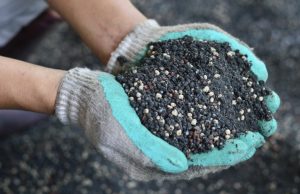 Many waste products contain phosphorus. Therefore, you can prepare a useful fertilizer with your own hands, without resorting to wasting money. For example, wood ash contains more than 30 different elements, including phosphorus. It is known that ash does not contain chlorine, which means it is the best way to fertilize tomatoes.
Many waste products contain phosphorus. Therefore, you can prepare a useful fertilizer with your own hands, without resorting to wasting money. For example, wood ash contains more than 30 different elements, including phosphorus. It is known that ash does not contain chlorine, which means it is the best way to fertilize tomatoes.
Superphosphate can be made from bones. To do this, the bones are ignited on the fire, burning off the organic compounds. As a result, calcium phosphate remains - a necessary substance for us. Next, the bones are crushed into crumb, mixed with chalk (lime) and sulfuric acid is added (it is first mixed with water). The mixture gradually takes the form of a cream or paste, and then turns into a white powder - superphosphate. It is used as a fertilizer for tomatoes.
Terms of making phosphate dressings
Phosphorus is necessary for tomatoes at all stages of the growing season:
- Sowing stage. Seeds are treated with growth stimulants — phosphorus-based complex products. Most commonly used are Humate, Appin, Kornevin, Zircon. They help to increase the stability of future plants, protect against diseases and pests.
- Fertilizer seedlings. Immediately after the appearance of the first leaves and the pickling of the seedlings, the young bushes are fed on the nitroammofoska brand A, which contains the highest dose of phosphorus. The product is diluted in water and sprayed over the seedlings. This will strengthen the tomatoes after the picking and allow the roots to grow faster.
- Back up the beds. Before planting seedlings, soil the soil with phosphorus-containing compounds. This occurs when digging the plot or the backlog of the beds. Most often used drug Kemir.
- Landing in the ground. At the time of planting seedlings strengthen the fortress. It can be scattered on the ground and good water, or use in liquid form (dissolved in water).
- The first feed. After 3 weeks it is recommended to carry out the first liquid feeding of seedlings with phosphorus. Any micronutrient based fertilizer can be used.
- Tomato flowering period. The introduction of phosphorus at this time contributes to the appearance of abundant ovaries. You can apply organic fertilizer (mullein or bird droppings). If organic matter is not recommended fertilizer nitrophoska.
- If the fertilizers were not laid before planting into the soil, then tomato growth will be improved by dissolving the drug with Mortar. They can spray plants or apply as a root fertilizer. Other effective tools suitable for processing bushes at different times of the growing season - Bio Master Red Giant, Kemira Lux, Universal.
Attention!
Concentrated phosphorus-containing drugs can be used no more than twice per season.
Phosphoric fertilizing is very important for the full life of tomatoes. There are many preparations containing the necessary microelement, many of which also contain other useful chemical compounds. What kind of fertilizer to choose depends not only on the preferences of the gardener, but also on the condition of the soil and most importantly of the plants themselves. Approach the choice of phosphate fertilizers wisely and then you get an early and tasty crop of tomatoes.


